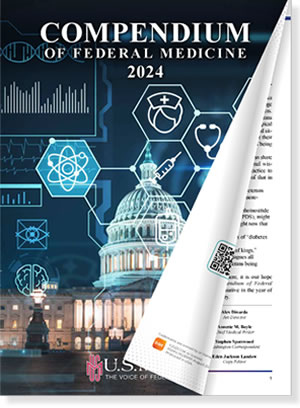
William Cushman, MD, Medical Director, Department of Preventive Medicine, and Professor of Preventive Medicine, Medicine, and Physiology at the University of Tennessee Health Science Center in Memphis, TN.
MEMPHIS, TN — As part of our ongoing series highlighting milestones in federal medicine as part of the 60th anniversary of U.S. Medicine, we spoke with William Cushman, MD, medical director, Department of Preventive Medicine, and professor of Preventive Medicine, Medicine, and Physiology at the University of Tennessee Health Science Center in Memphis, TN. He retired in 2020 from his position as chief of the Preventive Medicine Section at the Lt. Col. Luke Weathers Jr. VAMC in Memphis, where he served as a lead investigator on the Action to Control Cardiovascular Risk in Diabetes (ACCORD) trial.1
This pivotal study reshaped how diabetes is managed, particularly in patients at high cardiovascular risk. The following year, the Veterans Administrational Diabetes Trial published its findings from a 7-year study in 1,800 veterans, which confirmed the ACCORD results and played a critical role in the development of current VA and DoD clinical practice guidelines for the management of Type 2 diabetes mellitus.2
The interview has been edited for clarity and brevity.
At the time ACCORD began, what was the prevailing view regarding diabetes management and targets for A1c levels?
Around 2000, when the ACCORD trial was initiated, there was significant focus on the higher cardiovascular risk in patients with diabetes. Observational studies suggested a linear relationship between hemoglobin A1c levels and cardiovascular risk—the higher the A1c, the higher the risk. That led to the idea that reducing A1c to below six might significantly lower cardiovascular events.
What prompted ACCORD investigators to examine the effect of intensive glucose management on cardiovascular disease (CVD)?
The higher cardiovascular risk in diabetes and the observational data showing lower risk with lower glucose levels prompted several studies, including ACCORD, the VA Diabetes Trial (VADT) and ADVANCE. ACCORD aimed to determine whether achieving an A1c below six would benefit cardiovascular outcomes.
The glycemia arm of the study produced unexpected results. Can you explain?
The glycemia part of ACCORD not only didn’t show a benefit but revealed a significant increase in mortality after about 3½ years. That caused the intensive glycemia intervention to be stopped early. The blood pressure and lipid arms of the study continued and were reported separately.
Why do you think the intensive glycemia intervention led to increased mortality?
We analyzed a lot of data but couldn’t pinpoint a definitive reason. There was more hypoglycemia in the intensive group, which was thought to contribute to higher mortality, but we couldn’t establish a direct link. It wasn’t the specific drugs used, but we now know that none of those drugs reduced events the way newer diabetes drugs can.
How did these findings influence diabetes management?
ACCORD, along with VADT and ADVANCE, showed no cardiovascular benefit—and potential harm—from aiming for A1c levels below 6 in high-risk patients. Since then, guidelines have become more conservative. The American Diabetes Association typically recommends A1c targets below 7, with some exceptions. Targets between 7 and 8 are considered appropriate for patients at high cardiovascular risk, balancing the benefits for microvascular outcomes like retinopathy against the risks of intensive treatment.
How has diabetes management evolved with newer medications?
The newer diabetes drugs, such as GLP-1 receptor agonists and SGLT2 inhibitors, have cardiovascular benefits that older drugs didn’t. They’ve changed the landscape of diabetes treatment, focusing not just on glucose control, but also on reducing cardiovascular and renal risks.
The ACCORD trial’s findings have had a lasting impact on diabetes care, fostering a more nuanced approach that tailors A1c targets to individual patient needs and prioritizes safety alongside efficacy.
As a two-by-two study, participants in ACCORD were enrolled in either intensive management of hypertension or lipid levels as well as hyperglycemia. As you noted, the other two arms of the trial continued. What did the hypertension arm of ACCORD reveal?
The blood pressure part of ACCORD showed about a 12% reduction in cardiovascular events with a systolic blood pressure (SBP) target of 120 mmHg compared to 140 mmHg, but it wasn’t statistically significant. However, stroke risk was reduced by about 40%, which was significant, though it wasn’t the primary outcome.
When we looked at subgroups in ACCORD, there was a peculiar interaction where the patients in the intensive glycemic control group in the blood pressure trial had no benefit from blood pressure reduction, but the ones in the standard glycemia group, who didn’t have the higher mortality, and were part of the blood pressure trial, had a 26% reduction in cardiovascular events with the lower SBP target, which was significant.
How did the results of ACCORD’s blood pressure trial influence later studies, such as the Systolic Blood Pressure Intervention Trial (SPRINT), in which you led a clinical network of more than 20 VAMCs, and subsequent guidelines?
At the time, most people agreed the ACCORD blood pressure trial didn’t show definitive evidence of benefit, though there were promising signals. When the SPRINT trial came out in 2015, it showed a 25% to 30% reduction in cardiovascular events and mortality with 120 mmHg SBP target compared to 140 mmHg.3
After SPRINT, people retrospectively looked back at ACCORD’s blood pressure trial and largely reinterpreted it as showing benefit. In SPRINT, we excluded people with diabetes, but we did have a large group that had prediabetes and some who developed diabetes during the study. In that group, they had as much or more benefit as other patients with more intensive management and the lower goal. Guidelines have since moved toward lower blood pressure targets for people with diabetes, often recommending an SBP target of 130 mmHg, with growing support for 120 mmHg based on additional studies.
How do newer studies on hypertension in diabetes reinforce or challenge these findings?
Recently, the BPROAD study in China, which specifically looked at patients with diabetes, used the same design as ACCORD’s blood pressure trial and found a definite benefit of the 120 mmHg target in reducing cardiovascular events. It was a larger study, and its results confirmed what we suspected from ACCORD and SPRINT.4
How have ACCORD and subsequent studies shaped current guidelines?
Virtually all major guidelines—whether in the U.S., Europe, Canada or Australia—recommend SBP targets of 130 mmHg or lower, with some leaning toward 120 mmHg. The evidence from ACCORD, SPRINT, and subsequent trials has shown that people with diabetes benefit as much or more from intensive blood pressure control as those without diabetes.
What has been the broader impact of ACCORD on hypertension research?
ACCORD’s blood pressure trial contributed to a steady push toward lower SBP targets, which has been validated by more recent studies. It also highlighted the importance of subgroup analyzes and the potential for tailored approaches to managing cardiovascular risk.
- Action to Control Cardiovascular Risk in Diabetes Study Group; Gerstein HC, Miller ME, Byington RP, Goff DC Jr, Bigger JT, Buse JB, Cushman WC, Genuth S, Ismail-Beigi F, Grimm RH Jr, Probstfield JL, Simons-Morton DG, Friedewald WT. Effects of intensive glucose lowering in type 2 diabetes. N Engl J Med. 2008 Jun 12;358(24):2545-59. doi: 10.1056/NEJMoa0802743. Epub 2008 Jun 6. PMID: 18539917; PMCID: PMC4551392.
- Duckworth W, Abraira C, Moritz T, et al; VADT Investigators. Glucose control and vascular complications in veterans with type 2 diabetes. N Engl J Med. 2009 Jan 8;360(2):129-39. doi: 10.1056/NEJMoa0808431. Epub 2008 Dec 17. Erratum in: N Engl J Med. 2009 Sep 3;361(10):1028. Erratum in: N Engl J Med. 2009 Sep 3;361(10):1024-5. doi: 10.1056/NEJMc096250. PMID: 19092145.
- SPRINT Research Group; Wright JT Jr, Williamson JD, Whelton PK, Snyder JK, Sink KM, Rocco MV, Reboussin DM, Rahman M, Oparil S, Lewis CE, Kimmel PL, Johnson KC, Goff DC Jr, Fine LJ, Cutler JA, Cushman WC, Cheung AK, Ambrosius WT. A Randomized Trial of Intensive versus Standard Blood-Pressure Control. N Engl J Med. 2015 Nov 26;373(22):2103-16. doi: 10.1056/NEJMoa1511939. Epub 2015 Nov 9. Erratum in: N Engl J Med. 2017 Dec 21;377(25):2506. doi: 10.1056/NEJMx170008. PMID: 26551272; PMCID: PMC4689591.
- Bi Y, Li M, Liu Y, et al.; BPROAD Research Group. Intensive Blood-Pressure Control in Patients with Type 2 Diabetes. N Engl J Med. 2024 Nov 16. doi: 10.1056/NEJMoa2412006. Epub ahead of print. PMID: 39555827.

